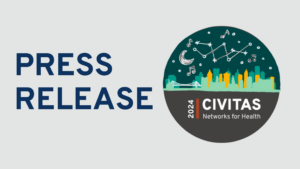Comprehensive health data exchange is a critical step in improving health outcomes. Understanding the landscape of National Health Information Organizations (HIOs) is more important than ever as we chart the path to national interoperability. In a Civitas member-only webinar in November 2023, the Civitas team presented the results of the Civitas supplement portion from the 2023 National HIO Survey sponsored by the Office of the National Coordinator for Health Information Technology (ONC) alongside a team from the University of California San Francisco’s Center for Clinical Informatics and Improvement Research (CLIIR) led by Principal Investigator, Julia Adler Milstein, Ph.D. This team worked closely with Civitas members, including HIEs and emerging Health Data Utilities (HDUs) nationwide. The data points extracted from the survey offer invaluable insights into the status, progress, and challenges of HIOs across the United States.
In this article, we’ll share key insights from our webinar discussion and data analysis.*
Navigating Medicaid Funding Pathways
Medicaid funding pathways play a pivotal role in the services and operations of HIOs; 96% either receive ongoing Medicaid match funding or have quality reporting partnerships in place with their State Medicaid Agencies (SMAs). The survey indicated a notable shift in how these organizations harness these pathways to sustain their operations and innovate and expand their services. Given the complex regulatory and financial environment surrounding Medicaid, this shift is significant.
HIOs are increasingly aligning their strategies with Medicaid reforms and initiatives, tapping into new funding opportunities that support the transition towards value-based care models. This alignment is critical for HIOs to stay relevant and effective in a health care system that is steadily moving away from fee-for-service models and better meeting the needs of underserved communities.
Expanding Partnerships and Network Connectivity
The survey also highlighted a trend toward increased collaboration across operators of health data infrastructure, as HIOs forge connections with national networks and engage in new initiatives like the Trusted Exchange Framework and Common Agreement (TEFCA). This trend indicates that HIOs strive to broaden their reach and interoperability capabilities. By participating in these national initiatives, HIOs are expanding their geographical coverage and enhancing their ability to exchange health information more efficiently and securely across different regions and health systems.
These partnerships are vital for HIOs to achieve interoperability that transcends local or state boundaries, which is essential in today’s health care landscape where patient mobility and cross-state health care delivery are commonplace. Furthermore, these collaborations provide HIOs a platform to share best practices, learn from each other, and collectively address common challenges.
Diversifying Revenue Streams and Services
Perhaps one of the most striking observations from the survey is the diversification of revenue streams among HIOs. In an environment where financial sustainability is a constant challenge (and just two years after a decade of HITECH Act federal subsidies ended), HIOs are finding innovative ways to diversify their funding sources. This diversification is not just a financial strategy but also a reflection of the expanding roles and services of HIOs.
By moving beyond traditional funding models, HIOs are exploring new avenues such as partnering with private entities, engaging in data analytics services, and venturing into areas like population health management. This expansion is particularly evident in their adoption of services that support value-based care models. HIOs are developing capabilities to provide more comprehensive data analytics, risk stratification, and quality measurement and reporting support. These services are crucial for health care providers operating under value-based contracts, requiring detailed and actionable patient data to improve care outcomes and control costs.
Health Information Exchange Support for Public Health Reporting and COVID-19 Response
The survey illustrated the critical function of HIOs in public health reporting, particularly during the unprecedented COVID-19 pandemic. The agility and responsiveness of HIOs in providing crucial data rapidly during this crisis cannot be overstated. This capability was especially pivotal in addressing health equity concerns, such as the disparities in COVID-19 impact and vaccine distribution across different races, ethnicities, and language groups. HIOs’ ability to collate, analyze, and disseminate data pertaining to these variables played a significant role in informing public health strategies and interventions, and strengthening public health infrastructure.
HIOs were instrumental in filling critical data gaps during the pandemic, enabling public health agencies to make informed decisions in real-time. This function was not limited to the collection and reporting of data but extended to providing insights into the socio-demographic aspects of health, which are crucial for understanding and addressing health inequities. HIOs’ contribution in this regard went beyond traditional health data management, encompassing a broader spectrum that includes social determinants of health. Their involvement ensured that public health responses were swift, nuanced, and sensitive to the diverse needs of communities.
Preparing for Future Pandemics with Health Information Organizations
The survey’s findings on HIOs’ involvement in public health reporting and response to COVID-19 are invaluable for preparing for future pandemics or health crises. The demonstrated ability of HIOs to rapidly mobilize and disseminate critical health information is a cornerstone in building a resilient public health system.
As we move forward, the role of HIOs is likely to expand further, not only in managing health data but also in predictive analytics and aiding the formulation of proactive public health strategies. Their involvement in identifying trends, predicting outbreaks, and facilitating a coordinated response across various healthcare and governmental entities will be crucial. This enhanced role of HIOs, as evidenced during the COVID-19 pandemic, positions them as indispensable assets in current and future public health endeavors.
The Future of Health Information Exchange
The comprehensive data presented in the webinar paints a picture of an industry in flux but poised for significant impact. As HIOs continue to adapt and evolve, their role in public health, regional and national interoperability, and health care policy become increasingly central to the information enterprise at the core of the modern health system. The survey results provide a snapshot of the current state of HIOs and offer a roadmap for their future development—including the ongoing shift of HIEs to the HDU model—and further integration into the broader health information landscape.
The National Health Information Organization survey results offer a deep dive into the evolving world of HIOs. By understanding their challenges, successes, and evolution, stakeholders can better appreciate these organizations’ integral roles in shaping the health care and health data interoperability landscape.
*More insights will be shared on the research, and more comprehensive data will be produced by our research partners in 2024.
We encourage you to reach out to the Civitas team with questions or to learn more about the research, and/or if you’re a Civitas member and want to be added to our event notification emails, please get in touch with our team.



